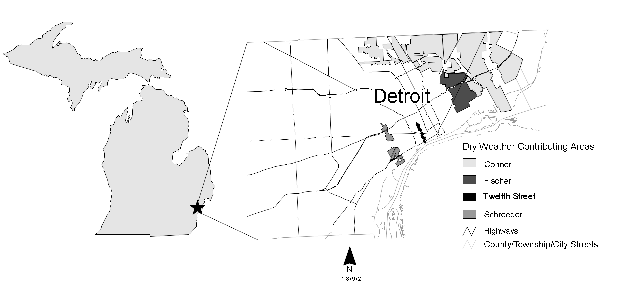The discharge of untreated sewage is illegal in Michigan unless permitted under Act 245 due to public health concerns. In October, 1992, the Michigan Department of Natural Resources (MDNR, now the Michigan Department of Environmental Quality) issued a discharge permit to Detroit authorizing discharge from the City's 78 combined-sewer overflows (CSOs), and requiring that a long-term control plan be developed to achieve mandated waterquality standards in receiving waters. The U.S. Environmental Protection Agency (USEPA) issued a national CSO policy in April, 1994, which requires (1) operational improvements of existing systems to minimize discharges and prevent their occurrence in dry weather; (2) publicly operated treatment works (POTW) to characterize the frequency and volume of discharges; and (3) construction of CSO discharge control projects where necessary.
In 1993, the Southeast Michigan Council of Governments (SEMCOG) requested assistance from the U.S. Geological Survey (USGS), in cooperation with Detroit Water and Sewerage Department (DWSD) and MDNR, Surface Water Quality Division, to address part of the technical data requirements for requirement 2. The USGS scope of services for this interdisciplinary, multiagency investigation consisted of collection, compilation, and interpretation of the necessary hydrologic data, and documentation of results. In addition to USGS personnel, personnel from DWSD assisted with the field collection of samples and in alerting USGS personnel to CSO effluent discharges.
From October 1, 1994 through December 31, 1995, four CSOs discharging to the Detroit River in Detroit, Michigan (figure 1) were monitored to characterize storm-related water quantity and quality. Water velocity, stage, and precipitation were measured continuously and recorded at 5-minute intervals. Water-quality samples were collected at discrete times during storms and analyzed for inorganic and organic pollutants. Discharges were sampled between 30 and 78 times for inorganic pollutants, and between 14 and 22 times for organic pollutants, depending on the site. These samples represented between 8 and 17 storms during which one or more of the four selected CSOs discharged. The monitored pollutants included fecal coliform, fecal streptococci, and Escherichia coli; antimony, arsenic, beryllium, cadmium, hexavalent chromium, total chromium, cobalt, copper, iron, lead, manganese, mercury, nickel, silver, thallium and zinc; and polychlorinated biphenyl congeners, volatile organic compounds, and polynuclear aromatic hydrocarbons. Metal and non-metal inorganic pollutants were detected at all sites. Many organic pollutants were not detected at all.

Figure 1. Location of Detroit, Michigan, and combined sewer sites monitored during this project.
The principal result expected of this investigation was the development of a data base of water chemistry, discharge volume, and storm frequency at each site studied. Results indicate that the instrumentation package designed for this project, and the field approach used, were correctly implemented to establish this data base. These data may be used by resource managers and scientists to (1) describe temporal variations for pollutant concentrations in combined-sewage from storm-to-storm; (2) describe spatial distribution of selected pollutants in four combined-sewer overflows discharging to the Detroit River; (3) calculate pollutant loads to the Detroit River from four combinedsewer overflows for monitored storm events; (4) estimate pollutant loadings from other combinedsewer overflow sites; and, (5) provide data and information which can be used to define appropriate management methods to reduce or eliminate untreated combined-sewer overflow discharges.
Differences in results between Schroeder Sewer, the most downstream CSO site studied, and the other three CSO sites which are upstream of Schroeder Sewer, indicate that processes may be active within the sewage transport system that have the potential to modify pollutant concentrations as combined storm sewage is moved through the system.
References:Contacts:
Mike Sweat, U.S. Geological Survey, Water Resources Division, 6520 Mercantile Way, Suite 5, Lansing, MI, 48911, (517) 887-8903, mjsweat@usgs.gov
Gary Fujita, Detroit Water & Sewage Department, 303 S. Livernois, Detroit, MI, 48219, (313) 297-5810, Fujita@crystal.water.ci.detroit.mi.us
City of Detroit Links
Walbridge Aldinger: Markets-Public Works/Institutional
Federal Highway Administration ( FHWA) Highway-Runoff Quality
